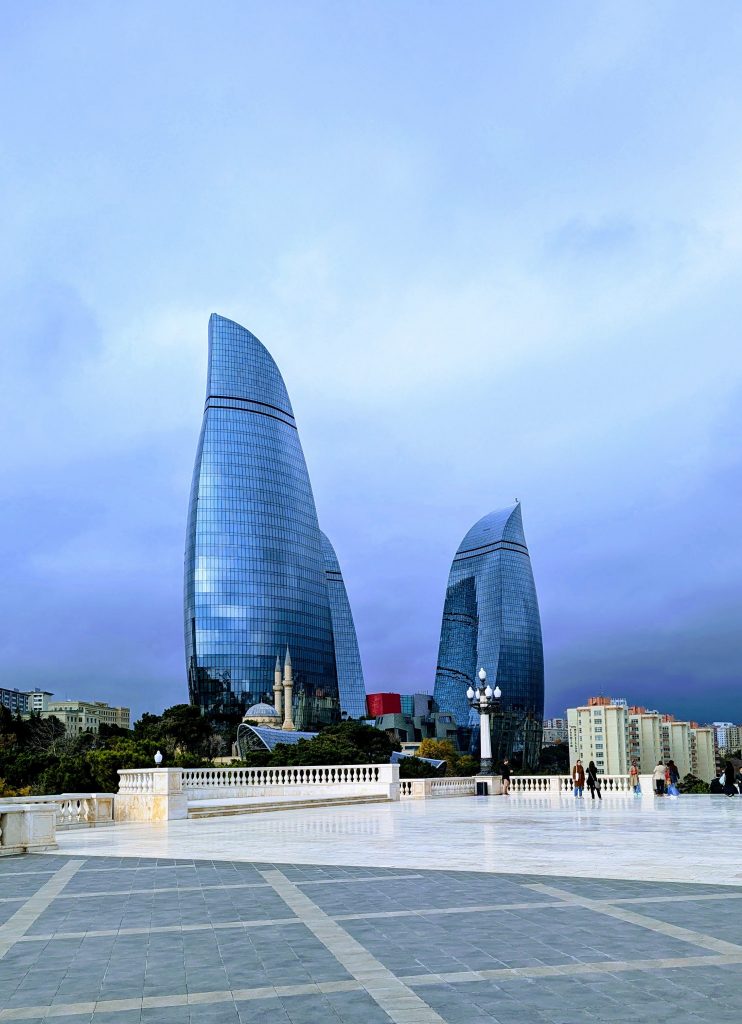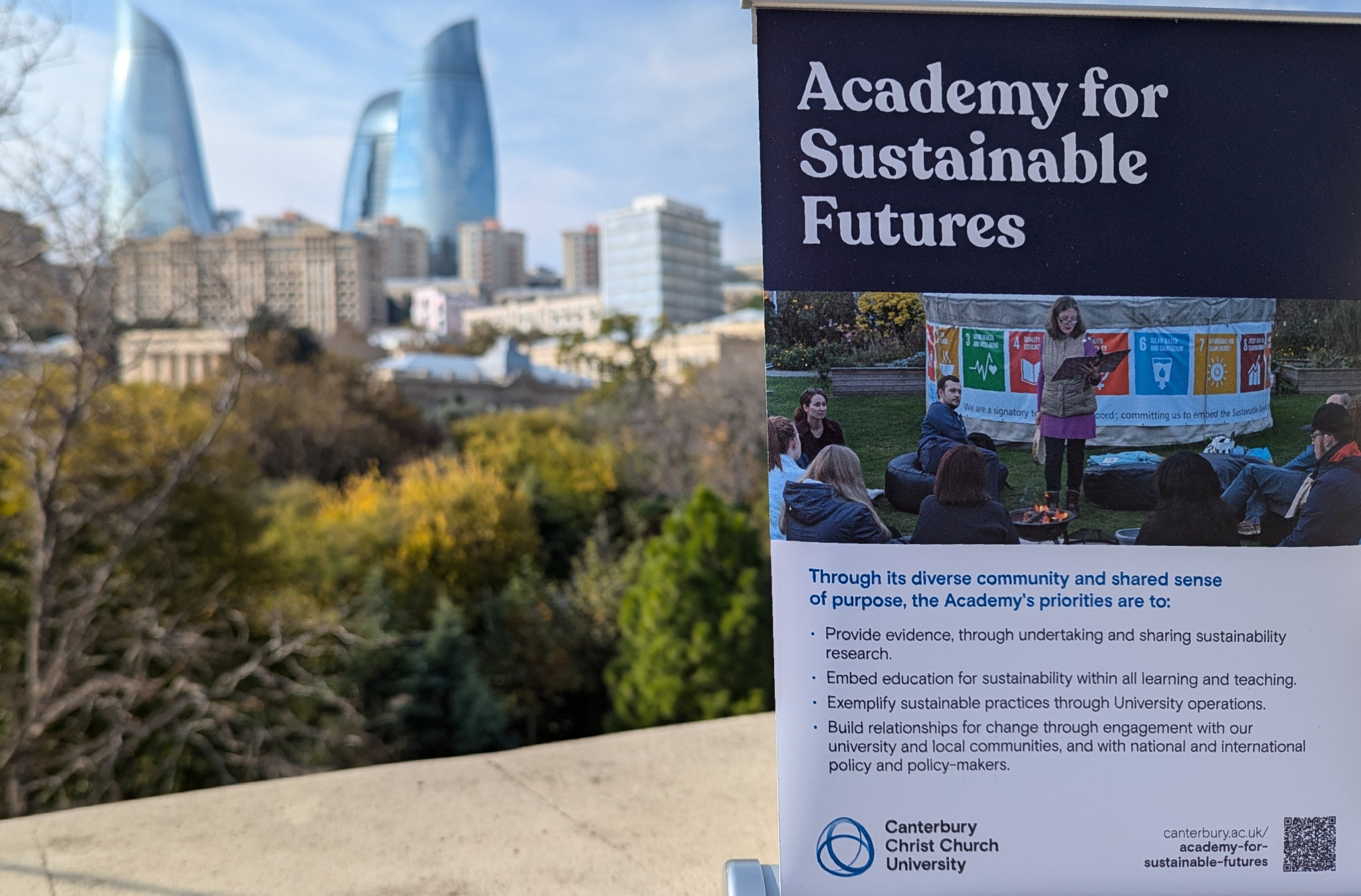Giles Polglase has returned from COP 29 and shares his reflections.
The 29th Conference of the Parties, commonly known as COP29, is currently underway in Baku, Azerbaijan. COP, which runs between 11-22 November 2024, is the United Nations Framework Convention on Climate Change (UNFCCC) annual global gathering and brings together world leaders, climate scientists, activists, and representatives from various sectors to address the urgent issue of climate change and sustainability.
This year Canterbury Christ Church University had two participants from the Faculty of Science Engineering and Social Sciences, attending the event: Dr Natalia Slobodian, Senior Research Fellow; and me, Giles Polglase, Faculty Registrar.
I was invited as a guest of ADA University, in Azerbaijan, to observe the proceedings and learn about how COP29 aims to build upon the outcomes of previous conferences. I also wanted to ensure that our Academy for Sustainable Futures and our BSc (Hons) in Politics and Global Sutainability were represented on the world stage.
What is COP29 aiming to achieve?
COP29 aims to implement the COP28 UAE Consensus and translate these commitments into concrete actions and policies. This includes finalising the operationalisation framework for the Loss and Damage Fund, which was established to provide financial assistance to vulnerable countries impacted by climate disasters.
A major focus of COP29 is to mobilise significant financial resources to support climate action in developing countries. This includes both public and private finance, with a particular emphasis on increasing climate adaptation finance. The conference also seeks to accelerate the global shift away from fossil fuels towards renewable energy sources. This involves promoting investments in clean technologies, strengthening energy efficiency measures, and phasing out fossil fuel subsidies.
COP29 is addressing the critical issue of climate adaptation, focusing on building resilience to climate impacts, such as extreme weather events, sea-level rise, and droughts. This includes developing early warning systems, protecting vulnerable communities, and promoting nature-based solutions. Furthermore, the conference aims to encourage countries to enhance their Nationally Determined Contributions (NDCs), which outline their climate action plans. This involves setting more ambitious emission reduction targets and strengthening climate policies.
Is there consensus and what are the challenges?
While there is a growing global consensus on the urgency of climate action, significant challenges remain in achieving the necessary level of ambition and cooperation. Key challenges include securing adequate and predictable climate finance, particularly for developing countries and this remains a major hurdle. Furthermore, the operationalisation of the Loss and Damage Fund is a complex process, and ensuring its effectiveness will require careful consideration. COP29 also needs to balance economic growth with climate action, as many countries face the challenge of trading-off economic development with climate mitigation and adaptation efforts. Finally, the conference directly addressed ongoing geopolitical tensions which are hindering international cooperation on climate change. COP29 represents a crucial opportunity to address these challenges and accelerate global climate action. The outcomes of the conference will have significant implications for the future of our planet and the well-being of generations to come.
What was COP29 like?
As an observer I was stunned by the sheer scale of the event. Over the 11-days around 65000 participants will have attended COP29. The venue is split into a number of zones. The Blue Zone is where the negotiations take place and the sheer number of negotiators, who included politicians, civil servants, members of non-governmental organisations, supported by their national delegations, was overwhelming. The national delegations had their own separate venue, with national pavilions. It was fascinating walking between the pavilions to see what each country was bringing to the event; and what they expected to be achieved. The United Kingdom pavilion focussed on how the country aims to reach net zero by 2050; whereas the Alliance of Small Island Nations were seeking to ensure the voices of small island nations are heard and their interests are protected, as these are the most vulnerable to sea level rise. The Green Zone, which is separated from the negotiations, serves as a more public and inclusive space compared to the formal negotiations of the Blue Zone. The Green Zone did have a lot of business representation, including finance and fossil fuel companies.



The view from Baku?
COP29 is an important global event and the politics playing on the shores of the Caspian Sea have real time consequences in our communities. I reflected on how the University is seeking to address these issues, through the formation of our Academy for Sustainable Futures and our new degrees, such as the BSc (Hons) in Politics and Global Sutainability. My main takeaway from COP29 is that education has to be at the centre of the climate change debate. Only through education and local action will we be able to make lasting changes which will have real impact. Already the world is setting its eyes on COP30 and I hope the legacy of Baku will begin to be realised before the next ‘meeting of the world’ in Brazil in 2025.
 Politics
Politics Laura Cashman
Laura Cashman 1046
1046


